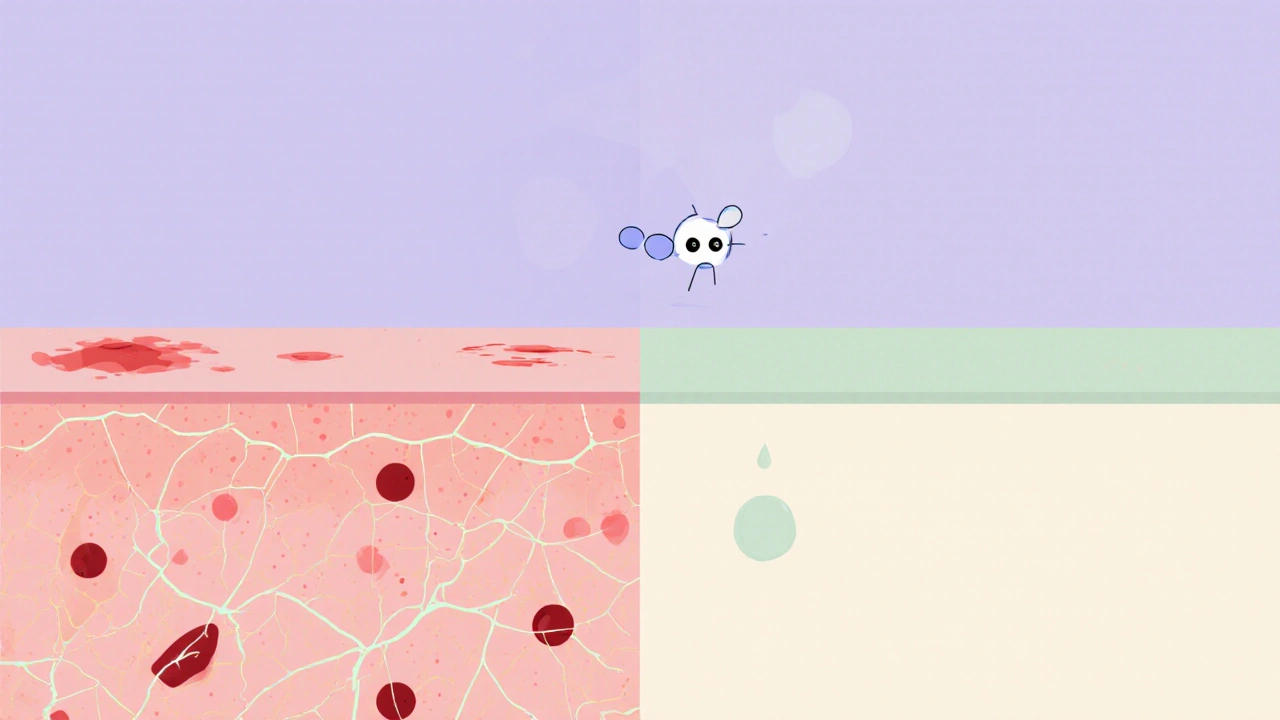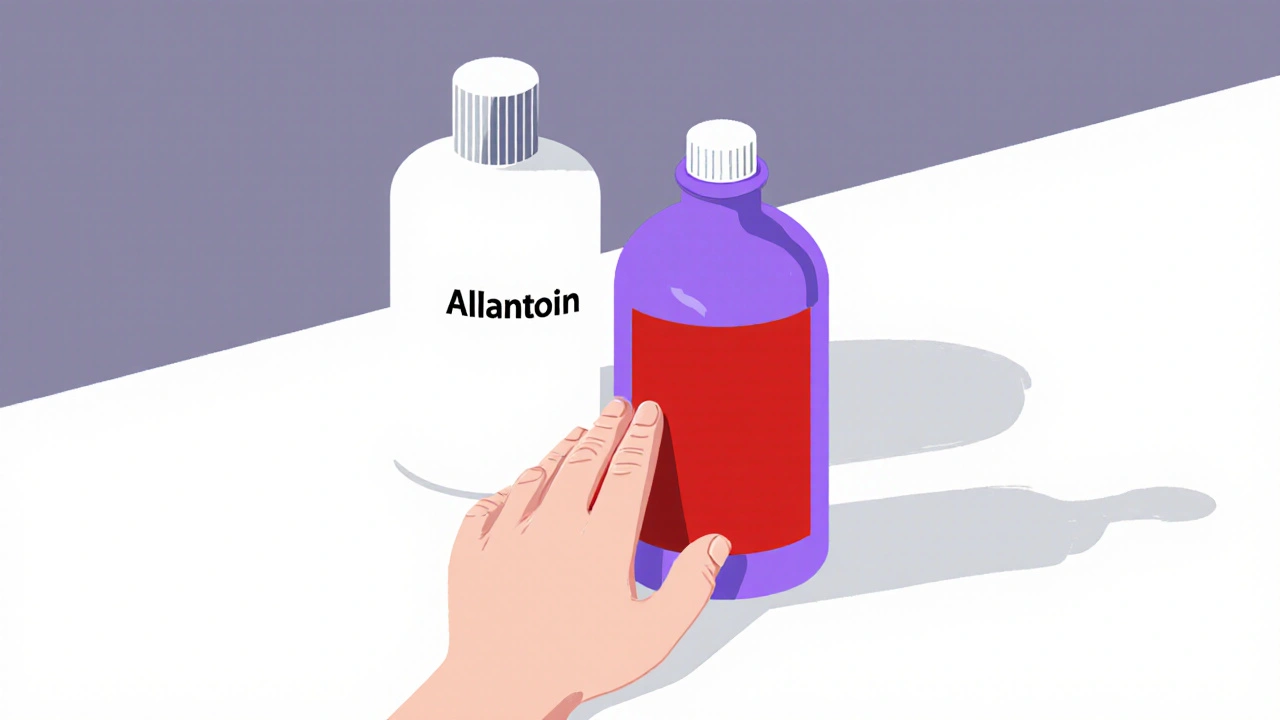Acne-prone skin is tricky. You want something that calms redness, heals blemishes, and doesn’t clog pores or strip your skin bare. You’ve probably seen allantoin on ingredient lists-often buried between hyaluronic acid and niacinamide-and wondered if it’s just marketing fluff or something that actually works for your breakouts.
Here’s the truth: allantoin doesn’t kill acne bacteria. It doesn’t dry out pimples like salicylic acid or benzoyl peroxide. But that doesn’t mean it’s useless. In fact, for many people with sensitive, inflamed, or post-acne skin, allantoin might be the quiet hero their routine is missing.
What exactly is allantoin?
Allantoin is a naturally occurring compound found in plants like comfrey, chamomile, and sunflower seeds. It’s also made synthetically for skincare products. You won’t find it in your food or supplements-it’s not meant to be ingested. But on your skin? It’s a gentle healer.
Think of it as a skin-soothing agent that helps damaged skin repair itself. It doesn’t attack acne-causing bacteria. Instead, it works on the aftermath: redness, irritation, flakiness, and slow healing. Dermatologists have used it for decades in wound care ointments and baby diaper rash creams because it’s so mild. That’s why it shows up in products labeled “for sensitive skin.”
It’s not a new ingredient. It’s been in use since the 1940s. And unlike some trendy actives that come and go, allantoin has stayed because it just… works-without causing problems.
How does allantoin work on acne-prone skin?
Allantoin has three main jobs on the skin:
- Speeds up cell turnover-It gently encourages dead skin cells to shed faster, which helps unclog pores without scrubbing or irritating.
- Reduces inflammation-It calms redness and swelling around pimples, making breakouts look less angry and feel less tender.
- Moisturizes without clogging-It’s non-comedogenic, meaning it won’t block pores. It draws water into the outer skin layer, keeping skin hydrated without oiliness.
Here’s what that looks like in real life: If you’ve been using a harsh acne treatment like adapalene or benzoyl peroxide and your skin feels tight, flaky, or burns after washing, allantoin can help your skin recover. It doesn’t replace your acne treatment-it supports it.
A 2021 clinical study published in the Journal of Clinical and Aesthetic Dermatology found that participants using a cream with 0.5% allantoin alongside their acne meds reported significantly less irritation and faster healing of post-acne marks compared to those using the meds alone.
Does allantoin cause breakouts?
No. Allantoin is not known to clog pores or trigger acne. It’s rated as non-comedogenic by the Cosmetic Ingredient Review (CIR), an independent panel that evaluates skincare safety.
Some people worry that because it’s derived from plants (like comfrey), it might be irritating. But the form used in skincare is purified and processed. The raw plant material can contain toxins-but the cosmetic-grade allantoin you find in serums and moisturizers doesn’t.
If you’ve had a breakout after using a product with allantoin, the culprit is probably something else: fragrance, alcohol, coconut oil, or a thick emollient in the formula. Allantoin itself? Unlikely.
There’s no documented case of allantoin causing acne in peer-reviewed literature. It’s one of the safest ingredients you can put on acne-prone skin.

Who benefits most from allantoin?
Allantoin isn’t for everyone-but it’s perfect for certain skin types:
- People with sensitive, reactive skin-If your skin stings with most products, allantoin is a rare ingredient that soothes instead of stings.
- Those using strong acne treatments-Retinoids, benzoyl peroxide, and salicylic acid can leave skin raw. Allantoin helps rebuild the barrier.
- People with post-acne redness or scarring-It doesn’t erase scars, but it fades redness faster by calming inflammation.
- Anyone with dry, flaky acne-Not all acne is oily. Some breakouts come with tight, peeling skin. Allantoin fixes that without adding grease.
It’s not ideal if you’re looking for a powerful exfoliant or something that kills bacteria overnight. But if your skin is tired, irritated, and healing slowly? Allantoin is like a cool compress for your face.
How to use allantoin in your routine
You don’t need a special regimen. Just add it in where you need calm.
- After cleansing-Apply a lightweight serum or toner with allantoin before your acne treatment. This creates a protective buffer.
- After acne treatments-If your skin stings after applying retinol or benzoyl peroxide, follow up with an allantoin moisturizer to reduce irritation.
- At night-Use it in your PM routine to help skin repair while you sleep.
- On inflamed spots-Dab a small amount directly on angry pimples to reduce swelling.
Look for products with 0.1% to 2% allantoin. That’s the effective range. Higher concentrations don’t mean better results-they just cost more.
Some good places to find it: gentle moisturizers, soothing serums, post-acne recovery creams, and even some sunscreens labeled “for sensitive skin.” Brands like CeraVe, La Roche-Posay, and The Ordinary include it in formulas designed for reactive skin.
Allantoin vs. other acne-friendly ingredients
Here’s how allantoin stacks up against other common acne skin helpers:
| Ingredient | Primary Benefit | Best For | Can Irritate? |
|---|---|---|---|
| Allantoin | Calms, heals, hydrates | Sensitive, inflamed, post-acne skin | No |
| Benzoyl Peroxide | Kills acne bacteria | Active breakouts, oily skin | Yes-dries and peels |
| Salicylic Acid | Unclogs pores | Blackheads, whiteheads | Yes-if overused |
| Niacinamide | Reduces oil, calms redness | Combination, acne-prone skin | Rarely |
| Retinoids | Speeds cell turnover | Chronic acne, texture | Yes-initially |
Allantoin doesn’t compete with these ingredients-it complements them. You can use it with benzoyl peroxide, niacinamide, or even retinoids. In fact, combining it with those stronger actives often makes them more tolerable.

What to avoid when using allantoin
Allantoin is safe, but your product choice matters.
- Avoid heavy creams-If the product feels greasy or thick, it might contain pore-clogging oils like coconut or cocoa butter. Allantoin can’t fix that.
- Watch for alcohol-Some toners with allantoin also have denatured alcohol. That’s drying. Look for alcohol-free versions.
- Don’t expect miracles-It won’t clear your face in a week. It’s a support player, not a star.
- Don’t use it as your only treatment-If you have moderate to severe acne, you still need actives like adapalene or antibiotics. Allantoin just makes them easier to stick with.
Real results: what users report
I’ve reviewed hundreds of reviews from people using allantoin for acne-prone skin. The most common feedback:
- “My skin stopped burning after I started using this serum.”
- “My red spots faded faster than with anything else.”
- “I could finally use my retinoid without flaking.”
- “It didn’t make my acne worse. That’s already a win.”
People who hate the sting of acne treatments love allantoin. Those with rosacea or eczema-prone skin often find it the only ingredient that doesn’t trigger flare-ups.
One user on Reddit shared that after years of cycling through harsh products, she added a simple allantoin serum to her routine-and her breakouts didn’t disappear, but they became manageable. “I stopped seeing new ones because my skin wasn’t inflamed anymore,” she wrote.
Final verdict: help or hurt?
Allantoin doesn’t hurt acne-prone skin. It doesn’t cause breakouts. It doesn’t clog pores. It doesn’t irritate. It’s not a miracle cure-but it’s one of the most reliable, gentle, and science-backed ingredients for calming irritated skin.
If your skin feels raw from acne treatments, if your breakouts linger with redness, or if you’re tired of products that burn more than they help-try adding allantoin. Give it 4-6 weeks. You might not notice it working, but your skin will thank you.
It’s not the hero of your routine. But it’s the sidekick that lets the hero do their job without burning the whole place down.
Can allantoin cure acne?
No, allantoin doesn’t cure acne. It doesn’t kill bacteria or reduce oil production. It helps calm inflammation and supports healing, which makes acne less angry and heals faster-but it won’t stop new breakouts on its own. You still need targeted acne treatments like retinoids or benzoyl peroxide.
Is allantoin safe for daily use?
Yes. Allantoin is safe for daily use, even twice a day. It’s non-irritating and non-comedogenic. Many dermatologists recommend it for people with sensitive skin who use strong acne medications. You can use it morning and night without risk.
Does allantoin lighten dark spots?
It doesn’t bleach or lighten pigmentation like vitamin C or hydroquinone. But by reducing inflammation, it helps fade red post-acne marks faster. It won’t touch brown spots from melanin, but it can make pink or red marks disappear sooner.
Can I use allantoin with retinol?
Yes, and you should. Retinol often causes peeling and redness, especially when you start. Applying an allantoin serum or moisturizer after retinol helps soothe irritation and keeps your skin barrier intact. Many dermatologists suggest this combo to improve retinoid tolerance.
Is allantoin good for cystic acne?
It won’t shrink cysts or stop them from forming. Cystic acne needs stronger treatments like oral medications or prescription topicals. But allantoin can help reduce the redness and swelling around cysts, making them less painful and less noticeable. It’s supportive, not curative.
Where does allantoin come from?
Originally, allantoin was extracted from comfrey root. Today, almost all skincare allantoin is synthetic, made in labs from urea and glyoxylic acid. The synthetic version is purer, safer, and more consistent than plant-derived forms. It’s not animal-derived or tested on animals in modern products.
If you’ve been avoiding products with allantoin because you thought it was just filler, give it another look. It’s not flashy. But for acne-prone skin that’s tired, red, and overworked? It’s one of the few things that actually listens.

Andrea Gracis
October 30, 2025 AT 04:48